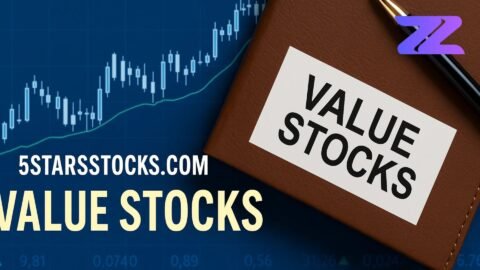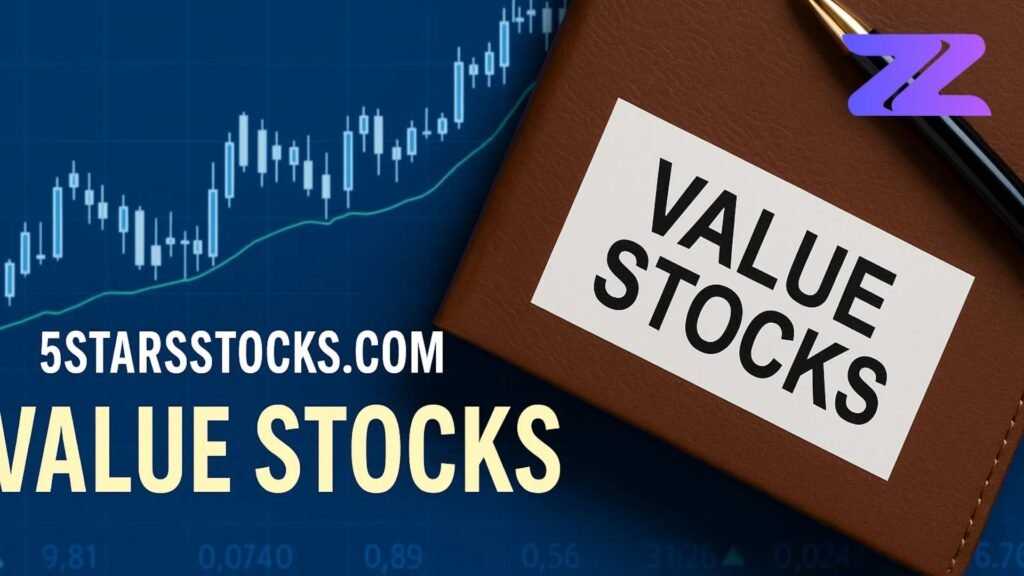Everyone loves getting a good deal at the market. In this way, are the cheap stocks the best choice? Value stocks are like those hidden deals, companies selling for less than they’re really worth. But not every “cheap” stock is a good one. The difference comes down to one crucial thing.
The safety is the gap between a stock’s current price and its real value. If this gap is high, then you’re buying with an extra protection. This simple gap idea will help you to choose the right stock. With it, you can make smart decisions, avoid from losses, and build a portfolio that stays strong even when markets go up and down. First know all about 5starsstocks.com Value Stocks then try it.
What Are Value Stocks? Know All About
Just as we all love finding discounts at the market, there are also “discounts” in the stock market, known as value stocks. These are companies that may be selling for less than their actual value. However, the challenge is determining whether it’s a genuine bargain or a bad deal.
The margin of safety means buying a stock for much less than what it’s really worth. Here, the gap matters a great deal; a larger gap can save you money. If you focus on this, you can avoid risky stocks. Select better companies and build a portfolio that remains resilient even when the market fluctuates.
Here is the detailed information, so you know everything about value stocks.
What Are the Value Stocks?
The value stocks are shares that trade at a lower price than what they’re really worth. Famous investors built their success by buying strong companies at cheap prices and waiting for the market to catch up. The primary goal is to mitigate risk while still generating steady returns. Unlike fast-growing stocks, value stocks don’t always rise quickly — but they’re usually safer.
Where Do You Find Them?
Value stocks are typically found in established, stable businesses such as utility companies, banks, or companies that produce everyday products. They may not be exciting or in the news, but they often provide investors with additional income through dividends. It will definitely reward you, although you may have to wait for the prices to increase. The main thing to focus on is always choosing companies that consistently make steady profits and manage their finances well, rather than worrying about short-term fluctuations in stock prices. Visit 5starsstocks.com Value Stocks for full details.
Value vs. Growth Stocks
Many investors chase big tech or growth stocks that can rise fast but also crash hard. The Value stocks often grow very slowly but recover more reliably. Here, you need to be patient, but it can help you keep your money safe during unstable market conditions.
Why Value Stocks Matter
Buying undervalued stocks gives you a margin of safety — a cushion in case the company’s profits drop or the economy slows down. It encourages you to study the real numbers, such as earnings and cash flow, rather than being swayed by hype. If you follow this research, you can make more informed decisions that are based on facts.
Value in a Balanced Portfolio
A mix of both growth and value stocks is an innovative approach. When fast-growing stocks slow down, value stocks can help you to balance your portfolio. Having both types together reduces stress, provides more stable returns, and enables you to handle different market conditions better.
Here is a brief guide about crypto30x.com ICE Token
Key Financial Metrics for 5starsstocks.com Value Stocks
If you want to find true value stocks, you just need to check a few significant numbers. Here are five main ones:
1. Price-to-Earnings (P/E) Ratio
A low P/E ratio indicates that a stock is selling at a lower price compared to the company’s earnings. Simply, you might be paying less for each dollar the company earns, which can be a sign of an undervalued stock.
2. Price-to-Book (P/B) Ratio
It tells the difference between the market price and the company’s actual asset value. It helps you see if you’re paying too much, whether they are paying more than what the company is truly worth based on its balance sheet.
3. Free Cash Flow Yield
The free cash flow yield indicates the amount of extra money a company generates compared to its total value. If this number is high, it suggests that the company is in a strong financial position. The company still has money left after paying its bills, which is a positive sign for investors.
4. Debt-to-Equity Ratio
The debt-to-equity ratio tells you how much a company uses borrowed money, as compared to its own money. A lower ratio is preferable because it indicates the company doesn’t rely too heavily on debt, making it safer and less risky for investors.
5. Dividend Yield
Many value stocks pay dividends ( extra income). Getting regular dividends is a benefit, especially when the company is stable and reliable.
How to Use Value Stock Metrics
You can check these numbers on finance websites or through your trading app. To see which companies stand out, always compare them with industry averages. For example, if a utility company’s P/E is below 12 and it gives steady dividends, it could be a good stock to check out more closely.
Avoiding Value Traps
Remember, cheap doesn’t always mean good. A stock can appear cheap because it has excessive debt or weak cash flow. That’s why you should always study several numbers together.
The Bigger Picture
Sometimes, the market drops, and many stocks appear to be cheap. However, strong companies with good cash flow, low debt, and steady profits typically recover more quickly. Please continue to monitor their P/E ratio, debt, and cash flow over time to identify patterns.
Why Building Your Watchlist
After finding a few good stocks, make a watchlist to keep track of them. A watchlist helps you stay focused and ready to act when the right time comes. Don’t add too many stocks — about 10 is enough to manage easily. You can use a simple spreadsheet or your brokerage app to follow essential numbers.
What to Track
In your watchlist, include details like:
- Current stock price
- P/E ratio
- Free cash flow
- Debt ratio
- Important news
You need to update this list regularly, ideally on a weekly or monthly basis. You can also use the color codes to stay organized, which are mentioned below:
- Red = Overpriced
- Green = Good deal
- Yellow = Needs more research
Set Alerts
To stay up to date with the top changes, you can set up alerts for price drops and company news. This way, you won’t miss a chance when a stock becomes cheap. By using the alerts, before purchasing, use a simple checklist to confirm details, such as dividend safety and the management changes.
Stay Organized and Disciplined
A watchlist helps you to avoid emotional decisions, and you will focused on facts. Check your list frequently, as markets are constantly changing. A stock that looked good three months ago might not be the same today. If it no longer fits your rules, remove it or hold it.
Why This Matters
Having a ready list of good stocks makes it easier to act quickly when opportunities come up. Over time, you’ll notice patterns and learn what really shows a stock’s actual value.
The Power of Long-Term Holding
Holding for the Long Term
Value investing works best with patience. Instead of buying and selling too often, hold on to good companies for many years. Over time, the market usually realizes their true worth. As Warren Buffett says, his favorite holding time for great companies is “forever.”
What to Watch While Holding
While you own the stock, keep an eye on:
- Yearly or quarterly company updates
- Steady or growing cash flow
- Manageable debt levels
- Regular and consistent dividends
If the company is still strong, don’t worry about small price drops. Instead, dips can be chances to buy more. Selling in panic often leads to losses.
Power of Dividends
Dividends are very important for value investors. If you reinvest them, your returns can grow faster through compounding. Many brokers allow automatic dividend reinvestment, making this simple. Even a 2% dividend adds up over time when the business also grows.
Tax Advantages
Holding stocks long-term also has tax benefits. In many cases, you pay lower taxes on long-term gains than on quick trades. This means you get to keep more of your profits.
Why Patience Wins
By holding strong value stocks for years, you avoid short-term noise and let your money grow steadily. This slow and steady approach builds wealth more safely over time.
How to Keeping Your Investments Safe
Managing Risk in Value Investing
Risk is always a part of investing, even when a stock appears to be undervalued. Some stocks can still fall further. That’s why it’s essential to have a plan to protect your money before you buy.
1. Set Exit Rules
Decide in advance when you’ll sell a stock.
- Set a stop-loss order to sell your stock automatically if the price drops below a certain level, helping you avoid significant losses.
- If you see any warning signs, such as rising debt or falling earnings, then sell.
2. Watch the Margin of Safety
The margin of safety is a gap between a stock’s real worth and its price. If the company is generating less profit and cash, you need to recheck your numbers to determine if the stock is still safe to hold.
3. Diversify Your Picks
Don’t put all your money into one type of stock. Invest across the different industries (like banks, utilities, or consumer goods). It can lower your overall risk.
4. Check Quarterly Reports
Every three months, review the company’s results.
- Did it meet its goals?
- Is debt getting too high?
- If things look bad, it may be time to step back.
5. Use Position Sizing
Only invest a small part of your total money in one stock. Many investors risk just 1–2% of their portfolio per stock. That way, even if one fails, it won’t ruin your whole plan.
6. Keep a Cash Reserve
Always save some cash. If the market drops, you’ll be ready to grab new bargains instead of worrying about being fully invested.
Closing Thoughts
Value investing with 5starsstocks.com Value Stocks is an easy and safe way to grow your money. If you will follow the simple financial metrics, such as the P/E ratio, cash flow, and debt, you can safe from the hype and can identify the good deals. A margin of safety can protects you from sudden market drops, and having a watchlist with clear rules helps you stay calm and you can make wise decisions.
This method needs patience. It’s all about the conducting thorough the research, holding strong companies for an extended period, and regularly monitoring them. Along with steady dividends, compounding growth, and less stress, value investing can slowly build your wealth. Start small but with a short list of quality stocks, track their progress, and follow true value guide your investment decisions.








